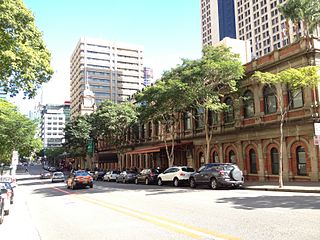
South Brisbane is an inner southern suburb in the City of Brisbane, Queensland, Australia. In the 2016 census, South Brisbane had a population of 7,196 people.

Burleigh Heads is a suburb in the City of Gold Coast, Queensland, Australia. In the 2016 census, Burleigh Heads had a population of 10,077 people.

Annerley is a suburb in the City of Brisbane, Queensland, Australia. In the 2016 census, Annerley had a population of 11,336 people.

Clayfield is a suburb in the City of Brisbane, Queensland, Australia. In the 2016 census, Clayfield had a population of 10,555 people.

Wynnum is a coastal suburb in the City of Brisbane, Queensland, Australia. In the 2016 census, Wynnum had a population of 12,915 people. The suburb is a popular destination in Brisbane due to its coastline, jetty and tidal wading pool.

Brisbane City is the central suburb and central business district of Brisbane, the state capital of Queensland, Australia. It is colloquially referred to as the "Brisbane CBD" or "the city". It is located on a point on the northern bank of the Brisbane River, historically known as Meanjin, Mianjin or Meeanjin in the local Aboriginal Australian dialect. The triangular shaped area is bounded by the median of the Brisbane River to the east, south and west. The point, known at its tip as Gardens Point, slopes upward to the north-west where the city is bounded by parkland and the inner city suburb of Spring Hill to the north. The CBD is bounded to the north-east by the suburb of Fortitude Valley. To the west the CBD is bounded by Petrie Terrace, which in 2010 was reinstated as a suburb.

Spring Hill is an inner northern suburb in the City of Brisbane, Queensland, Australia. In the 2016 census, Spring Hill had a population of 5,974 people.

Lota is an eastern outer coastal suburb in the City of Brisbane, Queensland, Australia. In the 2016 census, Lota had a population of 3,256 people.

Ann Street runs parallel to Adelaide Street and is the northernmost street in the Brisbane CBD in Queensland, Australia. The street is named for Anne, Queen of Great Britain, as part of the CBD street naming series of female British royalty. It is a major thoroughfare, linking as a four-lane one-way street the suburb of Fortitude Valley in the northeast with the Riverside Expressway in the southwest; house numbers run the opposite direction.

All Saints Anglican Church is a heritage-listed church at 32 Wickham Terrace, Spring Hill, City of Brisbane, Queensland, Australia. First founded in 1862, the current building designed by Benjamin Backhouse was completed in 1869, making it the oldest Anglican church in Brisbane. For most of its history, it has been identified with the High Church or Anglo-Catholic tradition within Anglicanism. It was added to the Queensland Heritage Register on 21 October 1992.

St Andrew's Uniting Church is a heritage-listed Uniting church at 131 Creek Street, Brisbane CBD, City of Brisbane, Queensland, Australia. It was designed by George David Payne and built in 1905 by Alexander Lind & Son. Initially St Andrew's Presbyterian Church, it became part of the Uniting Church following the merger of the Presbyterian, Methodist and Congregational Churches in 1977. It was added to the Queensland Heritage Register on 21 October 1992.

The Wharf Street Congregational Church was a Congregational church built in 1860 on the corner of Wharf Street and Adelaide Street, Brisbane, Queensland, Australia. The church was demolished in 1928. It was the first Congregational church in Brisbane.

Baptist City Tabernacle is a heritage-listed Baptist church at 163 Wickham Terrace, Spring Hill, Brisbane, Queensland, Australia. It was designed by Richard Gailey and built from c. 1889 to 1890. It was added to the Queensland Heritage Register on 21 October 1992. The church is affiliated with the Australian Baptist Ministries.

Inchcolm is a heritage-listed former office building at 73 Wickham Terrace, Spring Hill, City of Brisbane, Queensland, Australia. It was designed by Eric P Trewern and built in 1930 by J I Green & Son. It was converted into a hotel in 1998, and renovated in 2014. It now trades as Ovolo Inchcolm under the Ovolo Hotels Group. It was added to the Queensland Heritage Register on 23 March 1998.

Jacob's Ladder is a landmark in Brisbane, Queensland, Australia. It is a long pedestrian staircase that extends from Edward and Turbot Streets up to Wickham Terrace. The name is a reference to the Biblical stairway ascending to Heaven. Jacob's Ladder has 86 steps.

Clayton Wesley Uniting Church, formerly Clayton Congregational Church, is a Uniting church, located at 280 Portrush Road, Beulah Park, Adelaide, South Australia, Australia. The current building with its tall spire was built was built in 1883, although an earlier building, behind the present church and now known as the Lecture Hall, was built in 1856. The church is located in a commanding position at the eastern end of The Parade, Norwood.
Percival Watson was an English Congregationalist who had a considerable career as a minister in South Australia and Queensland.
Thomas "Tom" Rees Thomas MBE (1910–1993), generally referred to as T. Rees Thomas, often Rees-Thomas, was an Australian Congregationalist minister.

Edward Barton Southerden (1830–1906) was a businessman and politician in Brisbane, Queensland, Australia. He was the first mayor of the Town of Sandgate and was known as the "Father of Sandgate" as he was involved in all aspects of progress and welfare of the town.
Turbot Street runs parallel to Ann Street and is on the northern side of the Brisbane CBD in Queensland, Australia. It is a major thoroughfare, linking as a three-to-five lane one-way street with the Riverside Expressway in the southwest to the suburb of Fortitude Valley in the northeast; address numbers run the same direction. It is a one-way pair with Ann Street.


















